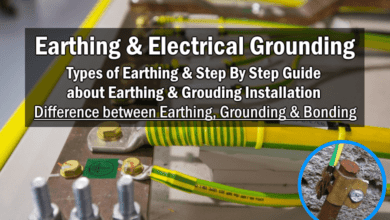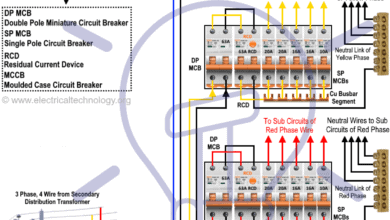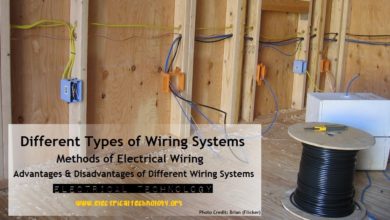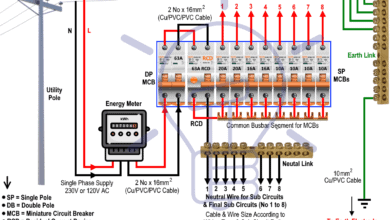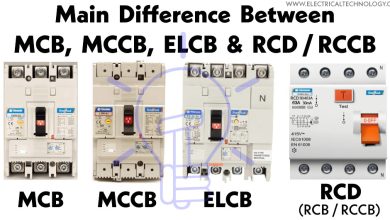Electric Fence – Working, Types, Protection & Installation
What is Electric Fence Protection Circuit? Components, Types, Operation and Applications
What is an Electric Fence?
An electric fence is a barrier used to contain/prevent animals or people from entering or leaving a certain area. It is used for controlling animals as well as for security purposes. The fence consists of an energizer connected with electrical conductors i.e. wires. The energizer sends pulses of high voltage that shock anything upon touching it.
The electrified fence is a mental barrier, not a physical one. It is a non-lethal deterrent that prevents animals from touching it. It does not harm animals but instead provides a brief shock that trains them to avoid contact. The electrical fence delivers a high-voltage pulse periodically, typically measured in pulses per second. The rate of the pulse depends on the design of the energizer.
Components in an Electric Fence
An electric fence has several components
Energizer
An energizer is an electrical device that converts the electrical energy from an outside source either DC or AC (from mains) and converts it into high voltage, high amperage, very short pulses. The pulses travel through a long electrical conductor. The pulse voltage range between 2000 volts to 6000 volts with a time rate of one pulse per second.
Block Diagram of energizer
The energizer can be of two types
Solar Energizer
Such an energizer is powered by solar panels with a rechargeable battery. It converts the DC power into a high-voltage pulse. The solar panels are directly connected to the energizer to energize the fence and also charge the battery.
They are portable, easy to install and set up. The solar panels convert the solar energy to charge the battery which eliminates the use of large cables from the mains. Place it anywhere on the ground near the fence, place the ground rod and connect its leads to the fence.
On cloudy days, the solar energy reduces and it cannot recharge the battery. Therefore the battery must be large enough to store charge for at least 4 days.
Advantages
Here are some advantages of Solar Energizer
- Its plug and play feature allows it to be used quickly.
- It is portable and can be placed anywhere.
- It does not require AC power from the mains.
- It does not have to be installed near the mains.
Disadvantages
Here are some disadvantages of solar energizer
- Physically, they are quite larger in size due to the battery
- It is heavier than the plug-in type.
- They are expensive compared to the plug-in type
- It is weatherproof and does not require extra protection against weather.
- It is vulnerable and easily be stolen
- It requires maintenance i.e. cleaning panels, battery maintenance, etc.
Plug-in and Battery Type
Such an energizer converts the AC input of 110/220 volts or the DC from the battery into high-voltage pulses. It can be categorized into further three types.
- Plug-in (AC) Energizer
- Battery (DC) Fence Energizer
- AC/DC Fence Energizer
Plug-in (AC) Energizer
The plug-in AC-type energizer only runs on AC 110/220 volts. It is installed in a fixed place inside the building, so it is not portable and requires a proper connection with the ground rods and the fence using an insulated wire. It is very cost-effective and the cheapest per joule.
Advantages
Here are some advantages of plug-in energizer
- It is very cost-effective.
- It does not have any output limitations
- It is quite smaller in size.
- It is lightweight as compared to the solar energizer of the same ratings
Disadvantages
Here are some disadvantages
- It is not portable and requires an AC outlet
- Its installation is not as convenient as the solar energizer.
- It is not weatherproof and requires extra protection to insulate the power lines.
Battery (DC) Energizer
Such an energizer converts DC from a battery into high-voltage pulses. It requires an external battery that is charged using an external charger. The unit i portable and can be placed near the fence, making it easier to install. It doesn’t require a mains outlet. However, a drawback is its reliance on an external charger for recharging the battery.
Advantages
- It is portable.
- It is easier to install.
- It does not require the mains 110/220 volt outlet.
Disadvantages
- It requires an external charger
- It is larger in size due to the battery.
- The battery requires maintenance.
- The overall cost is higher.
AC/DC Fence Energizer
Such an energizer has both the advantages of a plug-in (AC) and battery (DC) type energizer. The input from the mains 110/220 volts AC and battery DC can be used to energize the fence.
Related Posts:
- Why Can’t a 12V Car Battery Electrocute You?
- Why Don’t Birds and Squirrels Get Electrocuted on Power Lines?
Ground Rods
The grounding circuit is the most crucial part of the electrical fence. It provides the return path for the charge after shocking an animal. The energizer sends the high voltage pulse. When an animal touches the fence, the charge passes through its body to the ground. The ground passes the charge to the ground rod and the ground rod returns it to the energizer.
Therefore, if the ground terminals are not properly grounded, the path for the charge flow cannot be completed and the animal may not feel the necessary electric shock.
The grounding system requires at least 3 rods of about 6-8 feet long placed 3 meters apart as shown in the figure. The rods are placed 2 meters away from the energizer. The rods are connected through a galvanized wire (as they don’t rust). The grounding system is connected back to the energizer.
Keep in Mind
- Longer fences require more grounding rods.
- Dry, rocky lands require more grounding rods.
- The ground rods should not be connected to other utility grounds.
- The ground rods must be at least 20 meters away from the utility ground rods.
- The ground rods must not be near the telephone lines, water lines, etc.
Fence Line
The enclosure or exclosure is used to keep the animals or personnel in or keep them out. The fence line is mainly composed of the following components
The Fence Wire
The fence wire is stretched between posts at equal intervals to keep them spaced and upright. The wire is tightly secured at each post to provide support.
Insulator
The insulator is used to prevent the current flow between the charged wire and the post. It is made from materials that do not conduct electricity such as porcelain, ceramic and plastic, etc.
Posts
Posts are required to support the fence line. The spacing between the posts depends on the type of the ground. On level ground, its spacing can be as large as 20 to 30 yards while in hilly areas it is kept smaller.
Gates
The gate is used for entering or leaving the closure without the risk of being shocked. However, the current must pass from one side of the gate to the other. Therefore, a coated charged wire is passed underground.
Related Posts:
- Which One Kills – Current or Voltage and Why? Amps vs Volts
- Which One is More Dangerous And Why? AC or DC ?
- Which One is More Dangerous? 120V or 230V and Why?
How Does an Electric Fence Work?
An electric fence works by sending a periodic current pulse through single or multiple electric wires insulated from the earth. The insulation between the live and the earth prevents the circuit from completing. When an animal comes into contact with the live wire, its body completes the circuit to the ground. The current starts to flow from the live wire through the animal’s body and into the ground. The ground provides the return path to the Energizer.
Once the current starts flowing through the animal’s body, it flows through its muscles. These muscles suddenly contract causing a kick feeling that we feel during electric shock. It is this shock that prevents animals from touching the line. The electric shock does not physically harm or cause damage to the animals as it is very momentary. It creates a psychological barrier that the animals learn to respect.
Types of Electric Fences
The electric fence can be divided into the following types based on the wire configuration
One-Wire System
The one-wire system contains single or double strands of only charged wires. There are no ground wires being used. The ground rod is placed near the Energizer. The circuit is completed when an animal touches the charged wire and the current travel back through the ground. As the electric shock depends on the resistance of the soil and the distance between the ground rod and the animal, therefore such a fence is best used for a small area. Additionally, it can easily extend on an existing fence.
Two-Wire System
The two-wire system is comprised of one charged and one ground wire. The circuit is completed once the animals come in contact with the charged and the ground wire at the same time. The animal feels the full voltage shock. Therefore, such a system can be used for large areas. The charged and ground wires alternate each other such as charged wire, ground wire and then charged wire, etc.
Since the animal experience the full voltage shock, the two-wire system is best used for rocky, sandy areas and wooly or long hair animals.
All Live Wire Electric Fence
This is the conventional electric fence where only and only charged or live wire runs along the fence and a ground rod is installed near the fence. In such a configuration, a 10 k volt pulse flows through the live wire. The strength of the electric shock depends on the condition of soil. If the soil is wet, the animal will experience a full voltage shock otherwise in dry conditions, the voltage drops.
It is the cheapest and simple electric fence that is best for wet soil or small area. It is not suitable for large areas having rocky and sandy soil conditions.
Earth Return Wire Fence
In such a configuration, an earth return wire runs along the live wire throughout the fence. Such configuration allows it to provide full voltage shock even in dry soil conditions. There are two wires running along the fence i.e. live wire and a ground wire. 10 kV pulse flows through the live wire while the ground wire has 0 V.
If the animal touches just the live wire, it will receive an electric shock depending on the soil condition just like in a conventional electric fence. However, if it touches both wires, it will receive a full voltage shock irrespective of the soil condition. But there is a catch, since there is 0 V through the ground wire, touching only this wire will not shock the animal. It will be like touching the ground. This problem can be solved by using the bipolar electric fence.
Bipolar Electric Fence
In a bipolar electric fence, there are two different live wires running through the fence. It has positive and negative voltage pulses flowing through the fence hence the name bipolar electric fence.
It has three terminals i.e. positive terminal, negative terminal, and ground. Two separate live wires are connected to the positive and negative terminals while the ground terminal is connected to the earth using grounding rods.
A half-power positive voltage pulse flows through the positive live wire i.e. +5 k volts while a negative half-power pulse flows through the negative live wire i.e. -5 k volts.
If an animal touches only the positive line, it will receive a half-power shock through the ground. Also if it touches the negative power line, it will still receive a half power shock through the ground. However, if the animal touches both the live wires, it will receive the difference of the voltage between the lines (+5 kV and -5 kV) i.e. 10 kV the full power electric shock.
Advantages of Bipolar Electric Fence
The bipolar electric fence has several advantages over a conventional fence.
- Every line of the bipolar electric fence provides electric shock.
- Since bipolar fence lines carry half voltage pulse, it requires half of the minimum gap required between the line and the post to prevent arching through the insulator.
Related Posts:
- What Happens When Aircraft and Plane are Struck by Lightning?
- Why Avoid Plugging Space Heaters into Power Strips or Extensions?
Maintenance of Electrified Fence
Although electric fence does not need frequent maintenance but they require it every season. If it is really simple. All you need is a volt meter. Run it along the fence and find of the proper voltage is being delivered. Check for any vegetation or debris touching the fence. Check the Energizer if it’s working properly. If it is a solar-powered electric fence, check for the battery as well. You may want to replace the battery after a few seasons.
Precautions
There are some precautionary measures taken to ensure efficient use of the electric fence.
- Do not overtighten the fence wires. In winter, the wires will contract and pull the posts out of the soil.
- Do not power the gate wires, instead use underground coated wire to transfer power from one side to the other.
- Never power a Barb wire or use it with another charged wire.
- Make sure the fence is free from any vegetation or trees.
Advantages of Electric Fences
There are several advantages of electric fences over other fences such as barbed wires. Here are some of them given below.
- No Physical Damage: The shock provided by the electric fence is short-lived and does not cause physical damage such as barbed wires that cause severe cuts and pain. The electric shock teaches the animal to respect it psychologically.
- Longer Life: Electric fence has a longer life span as the animals rarely touch it after its first few shocks.
- Easier installation: it is easy to install using lightweight posts, wires and insulators.
- Less Maintenance: The electric fence requires very less maintenance because the animals rarely touch it.
- Low Cost: The overall cost is low as it requires less material and labor as compared to other types of fences.
- Simple and flexible: it is very simple to install and use. It is easier to divide or extend an existing fence.
Related Posts
- Why Don’t Bug Zappers and Fly Swatter Bats Kill Humans?
- Is Lightning AC or DC ?
- Why are Salt and Charcoal Added in Earthing Pit for Grounding?
- Which One is More Dangerous? 50Hz or 60Hz in 120V/230V & Why?
- What Happens if a Battery is Connected to the AC Supply?
- What Happens to the Battery with Reverse Polarity Wiring Connection
- Why Can’t We Store AC in Batteries instead of DC?
- What Happens When an AC Line Touches a DC Line?
- Electrical Shock Hazards & Its Effects on Human Body
- Personal Protective Equipment (PPE) for Electrical Works
- Protective Actions to Avoid & to Reduce Electric Hazardous
- Why Earth Pin is Thicker and Longer in a 3-Pin Plug?
- Why Does the Heating Element Glow but Not the Cord of Heater?
- Why are Stones laid in an Electrical Substation?
- What happens if You Connect a 3-Φ Induction Motor to 1-Phase Supply?
- What happens to the 3-Phase Motor When 1 Out of 3 Phases is Lost?
- What Happens if We Connect a Polar Capacitor the Wrong Way?









